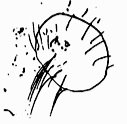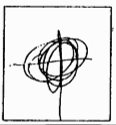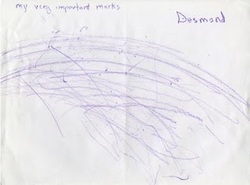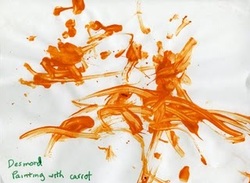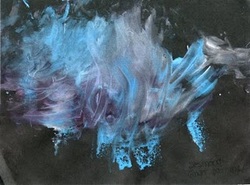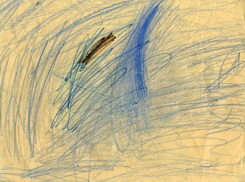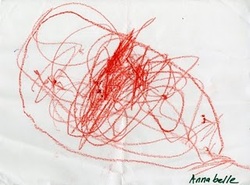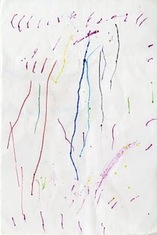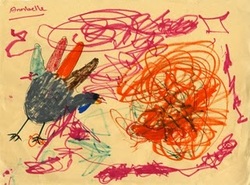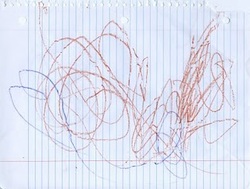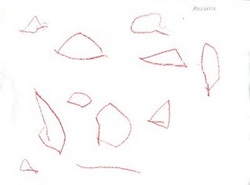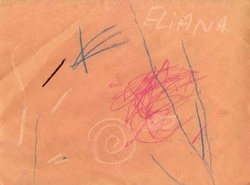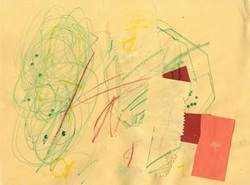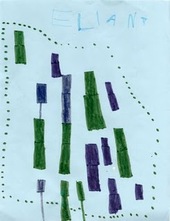The Scribbling Stage: The Beginning of Self-Expression
AGE: 18 MONTHS-4 YEARS
Babies spend many months absorbing their surroundings. As they take in the world around them, art becomes one of their first forms of communicating with the complex world around them. Toddlers first use tools without an awareness that their actions produce marks. After continued exposure to materials, children produce bang dots, initial marks generated by hitting some tool against a surface. Once young children make a cognitive connection ("Ah ha!") between symbol and tool, they move into the scribbling stage (Lowenfeld.)
Drawings created in the first years of life are visibly tangible expressions of pleasure. Pre=representational (Burton) drawings begin as a result of spontaneous, large muscle-motor movements and are kinesthetics, manipulative and expressive behaviors.
The first drawings made by a child are full of floating marks. The visual vocabulary youngsters produce is practically a universal code of marks termed:
1. mandalas (circular shapes);
2. combines (combinations of marks);
3. aggregates (roving continuous lines with little overlap)
4. radials (lines that radiate outward from a center); and
5. suns (enclosed circles with radiating lines.)
Drawings created in the first years of life are visibly tangible expressions of pleasure. Pre=representational (Burton) drawings begin as a result of spontaneous, large muscle-motor movements and are kinesthetics, manipulative and expressive behaviors.
The first drawings made by a child are full of floating marks. The visual vocabulary youngsters produce is practically a universal code of marks termed:
1. mandalas (circular shapes);
2. combines (combinations of marks);
3. aggregates (roving continuous lines with little overlap)
4. radials (lines that radiate outward from a center); and
5. suns (enclosed circles with radiating lines.)
Lowenfeld divides scribbling into three sub-stages: disordered and random scribbling, controlled scribbling, and planned scribbling. Unintentional marks become geometric shapes. By the end of this stage, children can make dots, straight lines, and closed forms. As learners begin to manipulate tools, gain confidence and develop their motor skills, these "accidental" marks become recognizable visual symbols and are combined to create complex formations.
Unintentional Marks
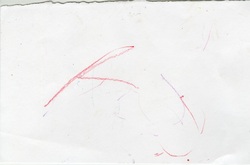
Anna, 16 months
Children are unaware of their first marks. For this drawing, Anna was given crayons and paper by an adult. She held the tools with her fist and made a few marks without a complete or true understanding that she was producing marks.
Her unknown power is suggested by the lightness and sparsity of the marks. A few changes in color can be seen, but those choices are the result of adult suggestions.
Disordered and Random Scribbling
Once children realize that the action of putting tool to surface creates a mark, they can begin making uncontrolled marks. This moment is often characterized by the appearance of the bang dot, the first connection children make between mark and mark-maker.
Characteristics to look for:
Characteristics to look for:
|
|
|
In this drawing, Desmond's obsession with bang dots is clear. The heavy pressure marks appear across the entire page. The drawing is also full of repeating single and overlapping horizontal lines that arch across the page.
Desmond used a carrot to produce this drawing. He held the tool with his whole hand, creating quick haphazard marks. A few of the marks wander off the edge of the page. The orange paint was probably chosen by an adult to relate the image with the painting tool (a carrot).
|
Desmond made this painting with his finders by dipping them into paint and running them across the black paper. He chose two colors (blue and white) that personally appeal to him. Some marks at the bottom of the central mass were made with a sponge, but he hasn't discovered his ability to make marks with his fingertips or whole hand yet.
In this drawing, Annabelle is still using the full force of her arm to draw with crayons and markers. She is beginning to select different colors in order to differentiate each mark. Her large, multiple diagonal lnies flow off the page, and her marks begin to vary--a roving open line and an enclosed line appear on the right side of the drawing.
|
Controlled Scribbling
Controlled scribbling is categorized by smaller, more organized lines and forms that are produced as children develop more muscle control. These new lines and forms are repeated over and over by children in a conscious effort to control and practice the range of marks they can produce. The development of this visual vocabulary is crucial to a child's understanding of the world. Through this personal journey, children learn that marks have meaning.
Characteristics to look for:
Characteristics to look for:
|
|
|
In the drawing to the left, Annabelle is beginning to realize that surface is different from the marks she can make. She still gains satisfaction by producing bang dots (as evidenced by the bits of whole crayon her dots left behind!) The dots are joined by multiple-line overlaid circles and roving enclosed lines that are now contained within the boundaries of the page. Using a red crayon, Annabelle has produced an advanced mandala.
This drawing shows a playful experiment in graphic dialogue. Greta began with a blank sheet of paper and an assortment of fine-tip markers. She started by drawing single vertical lines, changing her tool's color at will. A nearby adult began talking to her as she drew.
As a result of their dialogue, Greta began adding marks and inventing a story. Each line became a person--Babbo (daddy), Mama (mommy), Cosimo (her brother), etc.--that floats within the page's edges. The adult contributed to the drawing by imitating the marks that Greta made. By choosing different colors, she made her marks distinct from each other and was able to name marks after completing the drawing. THe result is an example of Majorie Wilson and Brent Wilson's "I draw-you draw" exercise. (Majorie and Brent Wilson). |
An adult helped Annabelle execute this drawing. After the grown-up traced Annabelle's left hand, the person helped Annabelle transform it by filling in the "stomach" and each "wing" with a different color.
When comparing the turkey on the left with the outline of Annabelle's right hand on the opposite side of the page, it is obvious that the energetic orange swirls were made by the 2 year old. Her color choices are becoming more specific, while roving lines completely cover the turkey's "body." The maroon marker marks are combines and aggregates that dance along three of the pages sides. Filling the page according to the space that's left, Annabelle confines her marks within the limits of the page. As Desmond watched his sister made a book of drawings, he suddenly got the urge to "help" by drawing on her pages. An adult quickly grabbed a piece of paper for him to make his own drawing. He picked up crayons and began putting tool to surface. The drawing is full of energy and a variety of scribbles overlap each other. After finishing the drawing, he proudly exclaimed, "Spaceship!"
As Marianne Kerlavage notes in chapter two of Creating Meaning Through Art: Teacher as Choice Maker, "Often after completing a drawing, painting, or construction, [children] name their manipulations and will invent stories or "romance" (Gardner, 1980) about them." By assigning a name to his scribbles, Desmond is beginning to realize that his marks have meaning. |
Planned (named) Scribbling
Drawings made as planned scribbles are carefully thought out.
Characteristics to look for:
Characteristics to look for:
|
|
|
Filling the page with single crossed circles and imperfect circles, Annabelle shows her ability to control her marks. Her fine motor skills are beginning to develop and her use of space is more orderly than in previous drawings.
The shapes are made more slowly and are ordered logically. By looking at the drawing, you can see that Annabelle was engrossed in the activity, giving each shapes its own space to breathe. The variety of marks present in Eliana's drawing reveals her ability to control her tool by using fine motor skills. She selected specific, aesthetically pleasing colors in order to make each mark distinct. Exploring the tools, Eliana fills the space haphazardly, placing marks down in the remaining empty spaces. Her marks dawn include: single vertical lines, single horizontal lines, single diagonal lines, a multiple-line overlaid circle and a spiral line.A
|
This paper, marker, and crayon collage was made by combining marks with cut shapes. The marks are organized in a spatial way. A numerous bang dots and a green crayon multiple-line overlaid circle occupies the left side of the page while a variety of multiple-line zigzags cut across the ride side of the page. Annabelle (or an adult assitant) cut out some paper shapes (with special scissors), creating zigzag edges, and overlapped them on top of the drawn marks.E
Eliana's drawing shows serious forethought in her ability to place a variety of close rectangular shapes on her paper. The blue and green shapes are filled in with heavy marker lines and connected by stacking one on top of another. In this drawing, Eliana builds on the principles of collage that Annabelle explored in the previous drawing. Straight vertical lines also connect some of the shapes to other shapes. A series of dots run along the perimeter of the cluster of closed forms; here they are used visually to enclose the group of rectangles.
|
